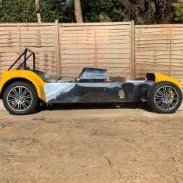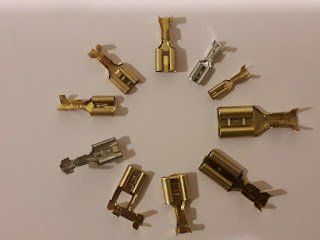-
Posts
123 -
Joined
-
Last visited
-
Days Won
3
Content Type
Profiles
Forums
Events
Store
Community Map
Posts posted by Chris Scott
-
-
Another question!
I have an Autosparks loom and a Trigger Wheel ECU loom.
The loom instructions say “the positive coil feed can be used as switched ignition for ECU.”
The TW loom instructions says one of the wires is “12v first click ignition”
Do I need to connect these? (Sorry if it’s a silly question)
I’ve attached pics…
Thanks
-
-
Thanks, I’ve got the aftermarket coolant rail and bike carbs on a custom inlet.
Ideally I just need the temp gauge one to work as I’m going to have the coolant fan on a switch.
-
So, having started the electrics, here comes the first of many (I suspect) questions!

The engine (Zetec Silvertop) has two sensors, does anyone know which is which - I assume one is gauge and one rad fan switch?
Also, both have 2 pins but only one wire, so I assume one pin just goes to earth?
Finally, do the sensors have a pos and neg or does it not matter?
Thanks in advance
-
Thanks both, I’ve got some proper fabric loom tape coming to neaten up and protect further - will look into some tubing as well.
It’s a brand new Autosparks loom, I’m no electrician so needed something that was plug and play(ish) - now I have a starting point I’m hoping it won’t be too bad to wire up!
-
So after weeks of procrastinating (through fear of the task) I finally started on the electrics today.
Having had several aborted attempts, I finally decided that the sensible path was to install the fuses and ecu first. I have built a small shelf to house the units (which sits above the passengers feet.
I would love to have made it from metal but don’t have the tools or materials - but painted plywood looks good and should do the job.
-
21 hours ago, nelmo said:
Not really got a name, but this is the kit I bought.
Just to clarify, I'm not saying this is the best way to do this, just what I eventually settled on. I still have lots of plugs just using these connectors as well which are still working OK.
 that’s ok, I won’t hold it against you!
that’s ok, I won’t hold it against you!
I do think those double crimps look to be the way to go, and given the other advice it’s the best (and easiest) method for me.
Thanks again, Chris
-
 1
1
-
-
8 hours ago, fry61 said:
Take a look at the Draper Ratchet Crimping Tool -- to be used with insulated terminals. The tool will not release the crimp before fully closed = completed crimp.
Will do, thanks

-
59 minutes ago, nelmo said:
I've tried numerous different methods. I started crimping because my soldering skills are rubbish but it turned out my crimping skills were just as bad and I had numerous problems.
I started soldering instead, which was sometimes OK but I still had issues because I was just so bad at it, making big, lumpy connections.
I then realised that I had being using my crimp tool incorrectly so I went back to crimping BUT I also soldered as well. I bought a kit full of these types of connectors:
So crimp in 2 places, once on the insulation, then on the bare end and then a blob of solder (I'm good at them) where the bare wire is visible.
If you want larger plugs, I strongly recommend these DT plugs - work really well and very secure.
Do you happen to know the name of these type of connectors? as I think that’s exactly the way I’ll go.
-
4 minutes ago, IanS said:
Remember that when soldering you will need strain relief beyond the end of the solder.
If the wire to a soldered joint is allowed to vibrate then there is a stress concentration at the end of the solder leading to early failure.
I worked in the aircraft industry and crimping was the prefered way to do connectors but we used calibrated crimp tools.
DT plugs are good but need the correct crimp tool, if done correctly then soldering harms rather than helps.
is one reasonable crimp tool.
Excellent, thank you. I’m wondering if it would be better to invest in a good crimper and quality plugs rather than a cheap soldering iron

-
55 minutes ago, nelmo said:
I've tried numerous different methods. I started crimping because my soldering skills are rubbish but it turned out my crimping skills were just as bad and I had numerous problems.
I started soldering instead, which was sometimes OK but I still had issues because I was just so bad at it, making big, lumpy connections.
I then realised that I had being using my crimp tool incorrectly so I went back to crimping BUT I also soldered as well. I bought a kit full of these types of connectors:
So crimp in 2 places, once on the insulation, then on the bare end and then a blob of solder (I'm good at them) where the bare wire is visible.
If you want larger plugs, I strongly recommend these DT plugs - work really well and very secure.
Thank you for the insight, this is exactly my worry - I fear I’ll make a pigs ear of any method
 Will look into those connectors though as they look to be of a good quality/design
Will look into those connectors though as they look to be of a good quality/design
-
2 hours ago, shaun_tomo88 said:
You’ve done well…. I’ve been following your rebuild for ages, wiring oh no I can’t get my head around it


Thanks, yeah I’m worried!!! The look looks easy enough to install and connect - but I’ll have to make some kind of custom but for ecu etc and I’m just terrified

-
-
Well, after a long journey I’m finally at the point where I need to install my new loom…and I’m terrified

The good news is it’s a brand new Autosparks loom with simple to follow instructions - the bad news is electrics frighten me! I’ve just no experience!
So the first silly question, what are the best connectors, I want simple but reliable. From what I can tell a lot of the engine bay will be eyelet, bullet and spade connectors - is it best to crimp these or solder? Any sets/kits of connectors people recommend?
Thanks, Chris
-
-
So…after a couple of months of forum inactivity I thought I would update the community on my progress…as there has been some!
The diff has been freed from its prison of corrosion, cleaned, resealed and refitted into a refurbished subframe. New stainless bolts and poly bushes have seen that looking so much better!
The backing plates and drums have been cleaned and painted and are now back on the car.
I have replaced the mounting plates for the subframe for thicker galvanised versions as well as patched the rear bulkhead.
The drivers seat is now fitted to new runners.
Finally, a friend has machined me a lovely ally plate to mount the new quick release for my steering wheel.
Next job will be mounting the steering column.
-
Thanks all, it’s all back together now - a pain to have the issues but a relief that it was only my carelessness not anything more serious!
-
2 hours ago, Sparepart said:
I am sure that you have accounted for this, but I have to say that the shafts are not the same length, the nearside is shorter than the offside, so are you sure you have them on the correct sides ? or you have received two long shafts by mistake ?.
Don’t be so sure I accounted for this



I removed this morning and looks like it was nearly all my fault

I will say that in my defence the strange thing is the shafts have the LH and RH threads the wrong way round (IMHO) as it would seem they would undo themselves as the car drove.
-
Evening all, weird one…
I’ve had my hubs/driveshafts rebuilt (new bearings and gaiters) went to fit yesterday.
RHS slid in and bolted up perfectly. Went to fit the LHS and it doesn’t fit, it slides into the diff, however the hub end is about 30mm away from the mounting point, it all binds up if I try to compress and bolt up.
Any ideas? I assume maybe the CV has come apart inside or something?
-
Thanks all…as always

-
20 hours ago, IanS said:
If imperial was a possibity I would say 31/64th inch. (worked in aircraft industry where imperial bolts still used with increments of 1/64) 31/64 would be 3rd oversize repair bolt for 7/16 initial bolt.
On most builds the rear subframe rubber donut was removed and a new hole drilled to fit a 12mm bolt throught the floor and reinforcing plate as advocated by RS in the build videos.
Now this interesting - because mine has an additional M12 bolt and the reinforcing plate - so maybe the other bolt is a little redundant. If that’s the case I’ll likely just go M12 for both
-
Evening all, does anyone know the dimensions of the big bolts that hold the rear subframe to the chassis?
I thought they were M12 but when they arrived the shouldered part seems too narrow.
I’ve measured the old bolts and it seems to be 12.4mm diameter so slightly bigger than M12, any ideas?
-
Thanks for the replies - sorry for my late reply. All sorted now luckily, just waiting on some parts then it’s time for the big reassemble
-
Thanks, it’s 100% one long bolt so either 6.5 or 7 - wonder if it’s my mistake as when I checked it says Sierra/Cosworth on my listing - would Cossie be different?
2 hours ago, richyb66 said:6.5" and 7" diffs have a single long bolt going from side to side across the top. 7.5" has 2 separate bolts.
The sizes refer to the crownwheel diameter.


























Alternator Light Terminal
in Electrics
Posted
That is incredibly helpful - thank you!!!